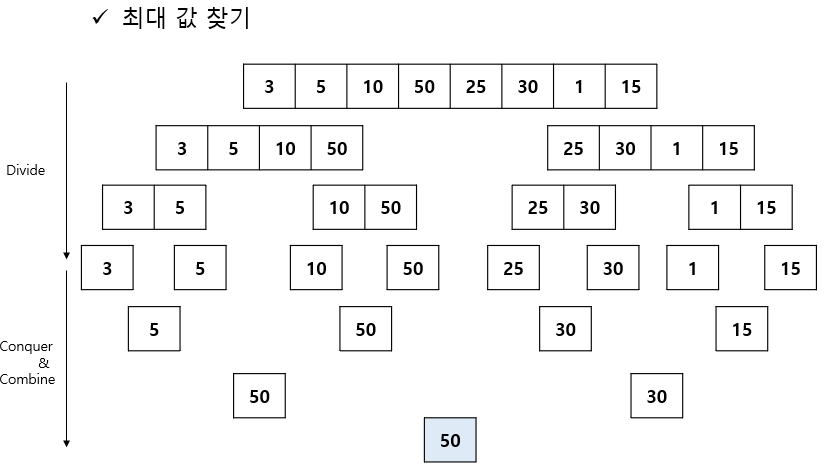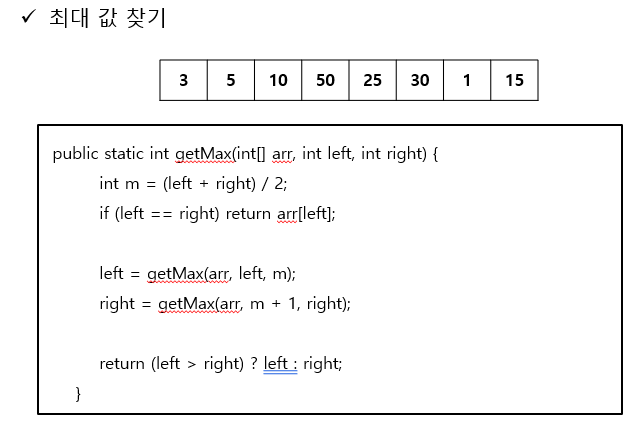분할 정복
분할 정복 (Divide and Conquer)
큰 문제를 작은 부분 문제로 나누어 해결하는 방법 - 합병 정렬, 퀵 정렬, 이진 검색, … 분할 정복 과정
- 문제를 하나 이상의 작은 부분들로 분할
- 부분들을 각각 정복
- 부분들의 해답을 통합하여 원래 문제의 답을 구함
분할 정복의 장/단점
장점 문제를 나누어 처리하며 어려운 문제 해결 가능 병렬처리에 이점이 있음 단점 메모리를 많이 사용 (재귀 호출 구조)
분할 정복 예시 (1)
분할 정복 예시 (2)
public class Main {
public static int getMax(int[] arr, int left, int right) {
int m = (left + right) / 2;
if (left == right) {
return arr[left];
}
left = getMax(arr, left, m);
right = getMax(arr, m + 1, right);
return (left > right) ? left : right;
}
public static void main(String[] args) {
int arr[] = {3, 5, 10, 50, 25, 30, 1, 15};
System.out.println(getMax(arr, 0, arr.length - 1));
}
}
50
문제풀이
// Practice1
// 정수형 배열 nums 가 주어졌다.
// 연속된 부분 배열의 합 중 가장 큰 값을 출력하세요.
// 입출력 예시
// nums: -5, 0, -3, 4, -1, 3, 1, -5, 8
// 출력: 10
// nums: 5, 4, 0, 7, 8
// 출력: 24
public class Practice1 {
public static int solution(int[] nums) {
if (nums == null || nums.length == 0) {
return 0;
}
return divideSubArray(nums, 0, nums.length - 1);
}
public static int divideSubArray(int[] nums, int left, int right) {
if (left == right) {
return nums[left];
}
// 좌우측 분할
int mid = left + (right - left) / 2;
int maxLeft = divideSubArray(nums, left, mid);
int maxRight = divideSubArray(nums, mid + 1, right);
// Conquer
int maxArr = getMaxSubArray(nums, left, mid, right);
return Math.max(maxLeft, Math.max(maxRight, maxArr));
}
public static int getMaxSubArray(int[] nums, int left, int mid, int right) {
int sumLeft = 0;
int maxLeft = Integer.MIN_VALUE;
for (int i = mid; i >= left; i--) {
sumLeft += nums[i];
maxLeft = Math.max(maxLeft, sumLeft);
}
int sumRight = 0;
int maxRight = Integer.MIN_VALUE;
for (int i = mid + 1; i <= right; i++) {
sumRight += nums[i];
maxRight = Math.max(maxRight, sumRight);
}
return maxLeft + maxRight;
}
public static void main(String[] args) {
// Test code
int[] nums = {-5, 0, -3, 4, -1, 3, 1, -5, 8};
System.out.println(solution(nums));
nums = new int[]{5, 4, 0, 7, 8};
System.out.println(solution(nums));
}
}
10
24
// Practice2
// 2차원 정수형 배열 lists 가 주어졌다.
// lists[i] 에는 각 링크드 리스트의 원소 정보가 들어 있고,
// 원소들은 오름차순 정렬된 상태이다.
// 모든 링크드 리스트를 하나의 정렬된 링크드 리스트로 합병하세요.
// 입출력 예시
// lists: { {2, 3, 9}, {1, 5, 7}, {3, 6, 7, 11} }
// 출력: 1 -> 2 -> 3 -> 3 -> 5 -> 6 -> 7 -> 7 -> 9 -> 11
class Node {
int val;
Node next;
Node(int val) {
this.val = val;
this.next = null;
}
}
public class Practice2 {
public static Node solution(Node[] lists) {
if (lists == null || lists.length == 0) {
return null;
}
return divideList(lists, 0, lists.length - 1);
}
public static Node divideList(Node[] lists, int left, int right) {
if (left == right) {
return lists[left];
}
// 링크드 리스트 좌우 분할
int mid = left + (right - left) / 2;
Node l1 = divideList(lists, left, mid);
Node l2 = divideList(lists, mid + 1, right);
return mergeList(l1, l2);
}
public static Node mergeList(Node l1, Node l2) {
if (l1 == null) {
return l2;
}
if (l2 == null) {
return l1;
}
Node merge = new Node(0);
Node cur = merge;
while (l1 != null && l2 != null) {
// l1 쪽이 작으면 해당 값으로 설정 후 l1 은 한 칸 이동
if (l1.val < l2.val) {
cur.next = l1;
l1 = l1.next;
} else {
// l2 쪽이 작은 경우
cur.next = l2;
l2 = l2.next;
}
cur = cur.next;
}
// 남은 쪽 연결
if (l1 != null) {
cur.next = l1;
}
if (l2 != null) {
cur.next = l2;
}
return merge.next;
}
// 문제에 주어진 2차원 배열을 링크드 리스트로 구성
public static void setUpLinkedList(Node[] node, int[][] lists) {
for (int i = 0; i < lists.length; i++) {
node[i] = new Node(lists[i][0]);
}
for (int i = 0; i < lists.length; i++) {
Node cur = node[i];
for (int j = 1; j < lists[i].length; j++) {
cur.next = new Node(lists[i][j]);
cur = cur.next;
}
}
}
// 결과 출력 부분
public static void printList(Node node) {
Node cur = node;
while (cur.next != null) {
System.out.print(cur.val + " -> ");
cur = cur.next;
}
System.out.println(cur.val);
}
public static void main(String[] args) {
// Test code
int[][] lists = { {2, 3, 9}, {1, 5, 7}, {3, 6, 7, 11} };
Node[] node = new Node[lists.length];
setUpLinkedList(node, lists);
Node combinedNode = solution(node);
printList(combinedNode);
}
}
1 -> 2 -> 3 -> 3 -> 5 -> 6 -> 7 -> 7 -> 9 -> 11
출처 : 제로베이스



Leave a comment